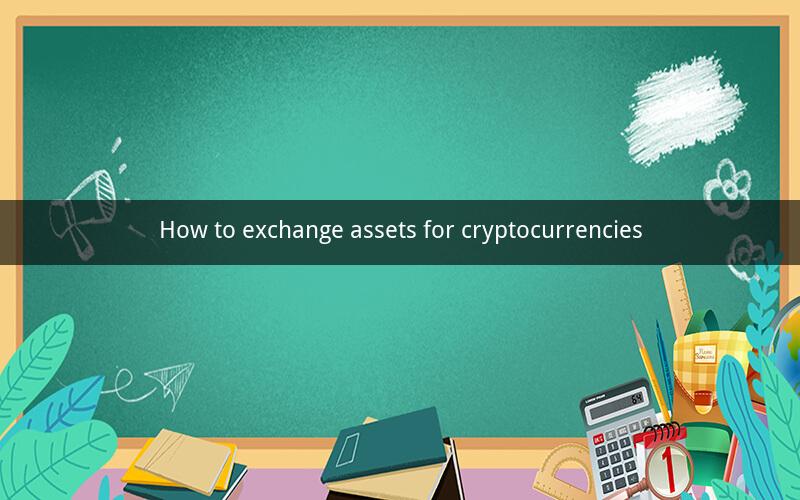
Table of Contents
1. Introduction to Cryptocurrency Exchanges
2. Understanding the Asset Exchange Process
3. Choosing the Right Cryptocurrency Exchange
4. Verifying Your Identity
5. Depositing Funds into Your Exchange Account
6. Navigating the Exchange Platform
7. Identifying the Cryptocurrency You Want to Exchange
8. Executing the Exchange
9. Withdrawal of Cryptocurrency
10. Security and Best Practices
---
1. Introduction to Cryptocurrency Exchanges
Cryptocurrency exchanges are platforms that allow users to buy, sell, and trade various cryptocurrencies. They act as intermediaries between buyers and sellers, facilitating the exchange of digital assets. Before diving into the process of exchanging assets for cryptocurrencies, it's essential to understand the basics of these exchanges.
2. Understanding the Asset Exchange Process
The asset exchange process involves several steps, including choosing an exchange, verifying your identity, depositing funds, navigating the platform, identifying the cryptocurrency you want to exchange, executing the exchange, and finally, withdrawing your cryptocurrency. Each step is crucial to ensure a smooth and secure transaction.
3. Choosing the Right Cryptocurrency Exchange
Selecting the right exchange is vital for a successful asset exchange. Consider factors such as fees, supported cryptocurrencies, user interface, security measures, and customer support. Some popular exchanges include Coinbase, Binance, and Kraken.
4. Verifying Your Identity
To comply with anti-money laundering (AML) and know your customer (KYC) regulations, you must verify your identity before using most exchanges. This process typically involves providing government-issued identification documents and proof of address.
5. Depositing Funds into Your Exchange Account
Once your identity is verified, you can deposit funds into your exchange account. You can do this by linking a bank account, credit/debit card, or other payment methods supported by the exchange.
6. Navigating the Exchange Platform
Once you have funds in your account, you can start navigating the exchange platform. Familiarize yourself with the layout, including the trading pairs, order types, and other features available.
7. Identifying the Cryptocurrency You Want to Exchange
Next, identify the cryptocurrency you want to exchange. You can do this by searching for the cryptocurrency's name or symbol on the exchange platform. Make sure you're exchanging the correct cryptocurrency and the correct amount.
8. Executing the Exchange
Once you've identified the cryptocurrency you want to exchange, you can place an order. You can choose to buy or sell, depending on your investment strategy. The order can be a market order (executed immediately at the current market price) or a limit order (executed at a specific price).
9. Withdrawal of Cryptocurrency
After the exchange is complete, you can withdraw your cryptocurrency to your external wallet. Make sure to use a secure wallet and double-check the address before initiating the withdrawal.
10. Security and Best Practices
Security is paramount when dealing with cryptocurrencies. Follow these best practices to ensure a safe and secure exchange experience:
- Use strong, unique passwords for your exchange and wallet accounts.
- Enable two-factor authentication (2FA) on your accounts.
- Keep your private keys secure and never share them with anyone.
- Regularly update your software and antivirus programs.
- Be wary of phishing scams and other fraudulent activities.
---
Questions and Answers
1. What is a cryptocurrency exchange?
- A cryptocurrency exchange is a platform that allows users to buy, sell, and trade various cryptocurrencies.
2. Why do I need to verify my identity?
- Verifying your identity is necessary to comply with anti-money laundering (AML) and know your customer (KYC) regulations.
3. How can I deposit funds into my exchange account?
- You can deposit funds by linking a bank account, credit/debit card, or other payment methods supported by the exchange.
4. What are the risks of using a cryptocurrency exchange?
- The risks include security breaches, regulatory changes, and market volatility.
5. How can I choose the right cryptocurrency exchange?
- Consider factors such as fees, supported cryptocurrencies, user interface, security measures, and customer support.
6. What are the different types of orders on a cryptocurrency exchange?
- The types of orders include market orders, limit orders, stop-loss orders, and take-profit orders.
7. How can I withdraw my cryptocurrency from an exchange?
- You can withdraw your cryptocurrency to your external wallet by entering the wallet address and confirming the transaction.
8. What is the best way to store my cryptocurrency?
- The best way to store your cryptocurrency is in a secure wallet, such as a hardware wallet or a reputable software wallet.
9. How can I protect myself from phishing scams?
- Be wary of unsolicited emails, messages, and calls asking for your personal information. Always verify the authenticity of the sender before providing any sensitive data.
10. What should I do if I lose my cryptocurrency?
- If you lose your cryptocurrency, there is no way to recover it. It's crucial to keep your private keys and backups secure to prevent such losses.